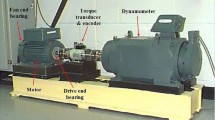Abstract
This study aims to monitor and detect bearing defects from measured signals on a wind turbine during 50 operating days using two methods. The first method involves a perceptual approach to classify the selected signals based on 50 measurements. The second method used is an unsupervised classification method called the Self-Organizing Map (SOM). Overall, the perceptive approach proved to be simple and effective compared to conventional methods of treatment and diagnosis of defects, as listeners were able to classify the selected sounds in the order of bearing degradation, allowing the severity of the bearing defect to be tracked. Furthermore, the neural classifier provided relevant information on the evolution of bearing degradation, as it could automatically cluster the vibration signal into four groups corresponding to the bearing life stages. Thus, these results can effectively contribute to well-timed maintenance decisions. In addition, the advantages and deficiencies of one method over the other are briefly discussed in this paper.















Similar content being viewed by others
References
60268–13 I (1998) Sound system equipment—part 13: listening tests on loudspeakers. International Electrotechnical Commission
Lipshitz SP, Vanderkooy J (1981) The great debate: subjective evaluation. J Audio Eng Soc 29(7/8):482–491
Vincent H (2005) Etude de la qualité sonore d’appareils de soufflage et de climatisation. M. Sc Thesis, Pierre & Marie Curie University, Paris
Parizet E, Hamzaoui N, Jacquemoud J (2002) Noise assessment in a high-speed train. Appl Acoust 63(10):1109–1124
Minard A (2013) Acoustic perception and comfort of air-treatment systems. Université de La Rochelle
Nacer H (2008) Prédiction du rayonnement acoustique des structures à partir de mesures vibratoires: Evaluation d’une méthode intégrale simplifiée en temporel. Rev Mécanique Appl Théorique 1(10):759–767
Abdelhamid M, Nacer H, Louis GJ (2010) Subjective evaluations of sound radiated by impacted plates, using the design of experiments method. Appl Acoust 71(6):531–538
Kohonen T (1982) Self-organized formation of topologically correct feature maps. Biol Cybern 43(1):59–69
Qiu H, Lee J, Lin J, Yu G (2003) Robust performance degradation assessment methods for enhanced rolling element bearing prognostics. Adv Eng Inform 17(3–4):127–140
Ferles C, Papanikolaou Y, Naidoo KJ (2018) Denoising autoencoder self-organizing map (DASOM). Neural Netw 105:112–131
Hu J, Zhang L, Liang W (2013) Dynamic degradation observer for bearing fault by MTS–SOM system. Mech Syst Signal Process 36(2):385–400
Moshou D, Hostens I, Papaioannou G, Ramon H (2005) Dynamic muscle fatigue detection using self-organizing maps. Appl Soft Comput 5(4):391–398
Li Z, Fang H, Huang M, Wei Y, Zhang L (2018) Data-driven bearing fault identification using improved hidden Markov model and self-organizing map. Comput Ind Eng 116:37–46
Zhao Z-l, Qiu Z-c, Zhang X-m (2016) Vibration control of a pneumatic driven piezoelectric flexible manipulator using self-organizing map based multiple models. Mech Syst Signal Process 70:345–372
Rai A, Upadhyay S (2017) Bearing performance degradation assessment based on a combination of empirical mode decomposition and k-medoids clustering. Mech Syst Signal Process 93:16–29
Depledt F, Sauvageot F (2002) Évaluation sensorielle des produits alimentaires. Techniques de l’ingénieur Biochimie alimentaire, analyses et alimentation humaine base documentaire : TIB470DUO (ref. article : f4000)
Lobreau-Callen D, Clément M-C, Marmion V (2000) Les miels. Techniques de l’ingénieur Filière de production : produits d'origine animale base documentaire : TIB432DUO (ref. article : f7000)
Crochemore S, Nesa D, Couderc S (2004) Méthodes d’analyse sensorielle des matériaux plastiques. Techniques de l'ingénieur Plastochimie et analyse physico-chimique base documentaire : TIB139DUO (ref. article : am3290)
Gouronnec A-M (2004) Analyses olfactométriques ou mesure des odeurs par analyse sensorielle. Techniques de l'ingénieur Analyses dans l’environnement : eau et air base documentaire : TIB831DUO (ref. article : p446)
Dreyfus G (2005) Neural networks: methodology and applications. Springer-Verlag Berlin Heidelberg
Du K-L, Swamy MN (2013) Neural networks and statistical learning. Springer-Verlag London
Younes R, Ouelaa N, Hamzaoui N, Djebala A (2015) Experimental study of real gear transmission defects using sound perception. Int J Adv Manuf Technol 76(5–8):927–940
Susini P, McAdams S, Winsberg S (1999) A multidimensional technique for sound quality assessment. Acta Acustica 85(5):650–656
McDermott BJ (1969) Multidimensional analyses of circuit quality judgments. J Acoust Soc Am 45(3):774–781
Suzuki T, Yasui S, Ojima Y (2010) Evaluating adaptive paired comparison experiments. In: Frontiers in statistical quality control, vol 9. Springer, pp 341–350
Mattila V-V (2002) Ideal point modelling of speech quality in mobile communications based on multidimensional scaling (MDS). In: audio engineering society convention 112. Audio Engineering Society
Wältermann M, Scholz K, Möller S, Huo L, Raake A, Heute U (2008) An instrumental measure for end-to-end speech transmission quality based on perceptual dimensions: framework and realization. In: Ninth Annual Conference of the International Speech Communication Association
Roussarie V (1999) Analyse perceptive de structures vibrantes simulées par modèle physique. Dissertation, Université du Maine, France
Zimmer K, Ellermeier W, Schmid C (2004) Using probabilistic choice models to investigate auditory unpleasantness. Acta Acustica 90(6):1019–1028
David HA (1988) The method of paired comparisons. Griffin C; Oxford University Press, London; New York
Acknowledgements
Acknowledgements are made for the measurements used in this work provided through http://data-acoustics.com/Database.
Author information
Authors and Affiliations
Corresponding author
Additional information
Publisher’s note
Springer Nature remains neutral with regard to jurisdictional claims in published maps and institutional affiliations.
Rights and permissions
About this article
Cite this article
Alia, S., Nasri, R., Meddour, I. et al. Comparison between sound perception and self-organizing maps in the monitoring of the bearing degradation. Int J Adv Manuf Technol 110, 2003–2013 (2020). https://doi.org/10.1007/s00170-020-06009-y
Received:
Accepted:
Published:
Issue Date:
DOI: https://doi.org/10.1007/s00170-020-06009-y




